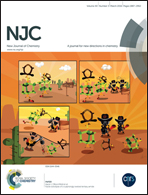One-step synthesis of Fe3O4/carboxylate-rich carbon composite and its application for Cu(ii) removal†
Abstract
Fe3O4/carboxylate-rich carbon composites (Fe3O4/CRC) have been synthesized via a facile one-step low temperature carbonization method from simple precursors, the single iron source FeSO4·7H2O, and sodium gluconate. Carboxylate groups from sodium gluconate can coordinate with Fe(II) and form ferricarboxylate complexes. During the low temperature carbonization process, Fe3O4 can be obtained through the thermal decomposition of ferricarboxylate complexes. In addition, sodium gluconate can serve as the source of the carboxylate functional group for Fe3O4/CRC. Due to the lower temperature of this carbonization process (300 °C), abundant carboxylate groups can remain in the amorphous carbon and serve as the metal-binding functional group to enhance adsorption affinity between Fe3O4/CRC and Cu(II). Fe3O4/CRC was found to be an ideal adsorbent for Cu(II) removal with a high adsorption capacity. We investigated how the contact time, temperature, pH, and initial concentration of Cu(II) can affect the adsorption of Cu(II) on Fe3O4/CRC. In addition, we also did some theoretical simulations on the Cu(II) adsorption model. Among the various kinetics models, the pseudo-second-order model gives the most suitable kinetics model for adsorption of Cu(II) onto Fe3O4/CRC. Adsorption of the heavy metals to Fe3O4/CRC reached equilibrium in less than 5 min, and agreed well to the Langmuir adsorption model with a maximum adsorption capacity of 66.67 mg g−1 at 25 °C. The adsorption–desorption studies indicated that Fe3O4/CRC possesses good stability and good reusability.


 Please wait while we load your content...
Please wait while we load your content...